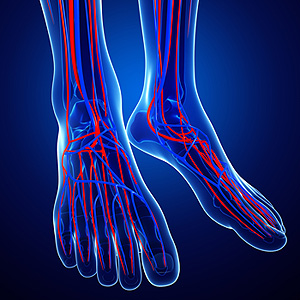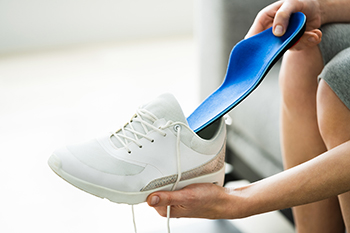Flint Office
1303 S. Linden Rd., Suite D
Flint, MI 48532

Flip-flops are easy to wear, which makes them a popular shoe choice for the summer months. Despite their simplicity, they may potentially harm the feet. Many flip-flops are made of flimsy materials and lack adequate cushioning in the heel area. Heel pain may ensue, possibly leading to plantar fasciitis. Pain may also develop in the middle of the arch which may be a symptom of tibial tendonitis. The toes may become cramped from keeping the shoe on the foot, and cause the entire foot to ache. People who enjoy wearing flip-flops may benefit from walking shorter distances in them or limiting the places they are worn. They are ideal shoes to wear to the beach, pool, or locker rooms, but are not suited for other environments. It is beneficial to purchase flip-flops that have a stiff sole, and this may help to provide adequate arch support. If you have questions about how flip-flops can affect the feet, it is suggested that you confer with a podiatrist who can provide you with useful information.
Flip-flops can cause a lot of problems for your feet. If you have any concerns about your feet or ankles, contact one of our podiatrists from Community Podiatry Group. Our doctors will assist you with all of your foot and ankle needs.
Flip-Flops and Feet
Flip-flops have managed to become a summer essential for a lot of people. While the shoes may be stylish and easy to slip on and off, they can be dangerous to those who wear them too often. These shoes might protect you from fungal infections such as athlete’s foot, but they can also give you foot pain and sprained ankles if you trip while wearing them.
When Are They Okay to Wear?
Flip-flops should only be worn for very short periods of time. They can help protect your feet in places that are crawling with fungi, such as gym locker rooms. Athlete’s foot and plantar warts are two common fungi that flip-flops may help protect your feet against.
Why Are They Bad for My Feet?
These shoes do not offer any arch support, so they are not ideal for everyday use. They also do not provide shock absorption or heel cushioning which can be problematic for your feet. Additionally, you may suffer from glass cuts, puncture wounds, and stubbed toes since they offer little protection for your feet.
More Reasons Why They Are Bad for Your Feet
If you have any questions, please feel free to contact our office located in Flint, MI . We offer the newest diagnostic and treatment technologies for all your foot care needs.

The feet are responsible for providing balance, mobility, and a steady base for the body. They also serve as shock absorbers while walking and running, and provide cushioning for the body. Each foot has 26 bones, several tendons, ligaments, and muscles that are naturally coordinated to function together. The muscles and tendons are categorized into two groups, labeled intrinsic and extrinsic. The muscles that start in the lower leg and wrap around the ankles before they attach to the foot are called the extrinsic muscles. The other group of muscles that are known as the intrinsic muscles begin and end in the foot. These muscles are layered along the bottom of the foot to form the arch. These groups of muscles work in harmony while walking and running and are not given much thought as it happens naturally. There are abnormal foot structures that can alter the natural alignment of the bones. People who have flat feet, babies that are born with clubfoot, or people who stand for long periods may develop chronic foot conditions. If you would like more information about how the feet are constructed, it is suggested that you speak with a podiatrist.
If you have any concerns about your feet, contact one of our podiatrists from Community Podiatry Group. Our doctors can provide the care you need to keep you pain-free and on your feet.
Biomechanics in Podiatry
Podiatric biomechanics is a particular sector of specialty podiatry with licensed practitioners who are trained to diagnose and treat conditions affecting the foot, ankle and lower leg. Biomechanics deals with the forces that act against the body, causing an interference with the biological structures. It focuses on the movement of the ankle, the foot and the forces that interact with them.
A History of Biomechanics
Modern technological improvements are based on past theories and therapeutic processes that provide a better understanding of podiatric concepts for biomechanics. Computers can provide accurate information about the forces and patterns of the feet and lower legs.
Understanding biomechanics of the feet can help improve and eliminate pain, stopping further stress to the foot.
If you have any questions please feel free to contact our office located in Flint, MI . We offer the newest diagnostic and treatment technologies for all your foot and ankle needs.

Common symptoms of poor circulation are tingling sensations in the feet after sitting for long periods or if exposed to cold elements. There may be existing medical conditions that can cause poor circulation. High blood pressure can be a common reason, as it could represent limited blood flow to the organs. People who smoke may be prone to developing poor circulation, and the effects are often felt in the lower legs and feet. Poor circulation may also happen from having endured a foot injury, which may constrict blood flow. It is important for patients who lead a sedentary lifestyle to move around as much as possible. Engaging in a gentle exercise program is an effective way to accomplish this, and can provide adequate circulation to the body. If you would like additional knowledge about how poor circulation can affect the feet, it is suggested that you confer with a podiatrist.
Poor circulation is a serious condition and needs immediate medical attention. If you have any concerns with poor circulation in your feet contact one of our podiatrists of Community Podiatry Group. Our doctors will treat your foot and ankle needs.
Poor Circulation in the Feet
Poor blood circulation in the feet and legs is can be caused by peripheral artery disease (PAD), which is the result of a buildup of plaque in the arteries.
Plaque buildup or atherosclerosis results from excess calcium and cholesterol in the bloodstream. This can restrict the amount of blood which can flow through the arteries. Poor blood circulation in the feet and legs are sometimes caused by inflammation in the blood vessels, known as vasculitis.
Causes
Lack of oxygen and oxygen from poor blood circulation restricts muscle growth and development. It can also cause:
Those who have diabetes or smoke are at greatest risk for poor circulation, as are those who are over 50. If you have poor circulation in the feet and legs it may be caused by PAD and is important to make changes to your lifestyle in order to reduce risk of getting a heart attack or stroke. Exercise and maintaining a healthy lifestyle will dramatically improve conditions.
As always, see a podiatrist as he or she will assist in finding a regimen that suits you. A podiatrist can also prescribe you any needed medication.
If you have any questions please feel free to contact our office located in Flint, MI . We offer the newest diagnostic and treatment technologies for all your foot and ankle needs.

Anyone with plantar fasciitis knows how much pain it can cause, and one of the ways to ease that pain is by using shoe inserts, or orthotics. The plantar fascia is a band of tissue that runs along the sole of the foot. When this tissue is torn from overuse, it becomes inflamed and a stabbing pain is mostly felt in the heel and arch. One of the major causes of plantar fasciitis is improper footwear. It is especially common in runners and women who frequently wear high heels. Shoes should have the proper arch support as well as ample cushioning to absorb shock. Special orthotics may be helpful in this regard, particularly in people with flat feet, high arches, or other biomechanical foot conditions. In these cases, ready-made shoe inserts may not be able to solve the problem. Custom orthotics made by a podiatrist can be exceedingly helpful because they are constructed to fit the contours of your feet perfectly and correct the problem areas. For more information, it is suggested that you make an appointment with a podiatrist for an exam.
If you are having discomfort in your feet and would like to try orthotics, contact one of our podiatrists from Community Podiatry Group. Our doctors can provide the care you need to keep you pain-free and on your feet.
What Are Orthotics?
Orthotics are inserts you can place into your shoes to help with a variety of foot problems such as flat feet or foot pain. Orthotics provide relief and comfort for minor foot and heel pain but can’t correct serious biomechanical problems in your feet.
Over-the-Counter Inserts
Orthotics come in a wide variety of over-the-counter inserts that are used to treat foot pain, heel pain, and minor problems. For example, arch supports can be inserted into your shoes to help correct overarched or flat feet, while gel insoles are often used because they provide comfort and relief from foot and heel pain by alleviating pressure.
Prescription Orthotics
If over-the-counter inserts don’t work for you or if you have a more severe foot concern, it is possible to have your podiatrist prescribe custom orthotics. These high-quality inserts are designed to treat problems such as abnormal motion, plantar fasciitis, and severe forms of heel pain. They can even be used to help patients suffering from diabetes by treating foot ulcers and painful calluses and are usually molded to your feet individually, which allows them to provide full support and comfort.
If you are experiencing minor to severe foot or heel pain, it’s recommended to speak with your podiatrist about the possibilities of using orthotics. A podiatrist can determine which type of orthotic is right for you and allow you to take the first steps towards being pain-free.
If you have any questions please contact our office located in Flint, MI . We offer the newest diagnostic and treatment technologies for all your foot and ankle needs.